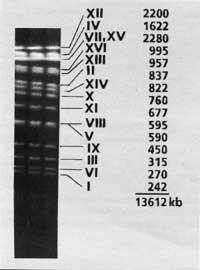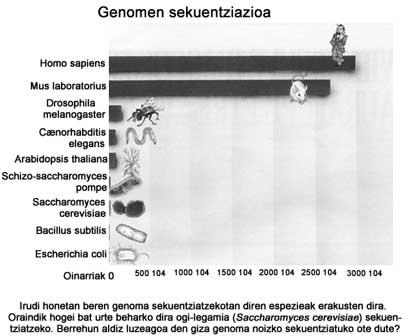Discovering the secrets of chromosomes
1993/11/01 Alargunsoro, F. Iturria: Elhuyar aldizkaria
For two years, 147 researchers worked in 35 European laboratories to sequence the third yeast chromosome (i.e., Saccharomyces cerevisiae). For the first time in the world they know all the bases of a chromosome.
Genome of bread yeast
It has sixteen chromosomes and here they are shown separated by electrophoresis. It contains a total of 13.612.00 nucleotides. It is observed that the third sequenced chromosome so far is one of the smallest.
Why did they choose this yeast to perform such an important study? This yeast, which has served for thousands of years to make bread, can serve as an example to all plants and animals around the world. In its genetic heritage there are also genes of insects, plants and human beings. However, since only the third of the 16 yeast chromosomes has been clarified, we hope that we still have many surprises. It is possible to find the insulin gene (which regulates the rate of sugar in the blood) or that produces cancer. Is not man the human being who has all the genes of this microscopic fungus and also his own?
Let's say that living organisms are classified in groups called prokaryote and Eucharistic. In prokaryotes (for example, blue bacteria and algae), the set of genes or the genome is not found in the nucleus of the cell that delimits it and in eukaryotes (in all other species) the genome is found in the nucleus of the cell. The leaven of bread is a simple eukaryote and man a more complex eukaryote. Therefore, if in yeast, for example, cancer genes or oncogenes were found, it would be a unique opportunity to analyze their influence on the human being.
However, the yeast of bread is not exclusively of medical interest. The different strains or slag of Saccharomyces cerevisiae are also used in the industry, in addition to bakeries, in the wine and beer industry, and in these activities they move billions of dollars. Therefore, around four thousand scientists in the world investigate whether one of the 600 in nature is one of the types of yeast.
The second and eleventh yeast chromosome, with more than half of the sequenced genes, is currently being studied in Europe. Chromosomes first, fifth, sixth, and ninth are being explored by researchers from Canada, the United States, Japan, and Great Britain respectively. In short, five other chromosomes 7, 8, 10, 14 and 15 will begin to sequence in the European network of laboratories and are expected to discover all the secrets of the yeast genome by the year 2000. The high level of information and the working systems that are then to be mastered will allow you to undertake greater tasks. For example, to fully study the human genome it will be necessary to sequence more than 50,000 genes and thousands of researchers around the world will have to do so.
But because of the amount of money and work involved in fully exploring the human genome, this task will not be finished tomorrow or past. At the time of its realization, the genes that produce more than 3,000 genetic diseases currently inventoried will be identified. In this way, a better understanding, treatment and, perhaps, prevention of these diseases is achieved.
Bread yeast has some advantages for research. Like bacteria (like Escherichia coli, for example), it is an easily manipulable unicellular organism, but being eukaryotic it has nucleus and biological functions as the superior living beings. Despite being two hundred times smaller than the human genome, the yeast genome contains all the information necessary for the life of the cell. In other words, it is a model of reduced cell size.
The nucleus of yeast can be considered a book formed by a molecule (DNA or deoxyribonucleic acid) that transmits the genetic message. Only four letters (base or nucleotide) are used to write the book: A (adenine), C (cytosine), G (guanine) and T (thymine). The book of yeast consists of sixteen chapters or chromosomes, with a total of 7,000 paragraphs or genes, each with the message of an inheritance genetic characteristic. The estimated total volume of the book is 13,600,000 letters or nucleotides.
The third chromosome analyzed in thirty-five European laboratories, of 182 genes, is one of the shortest chapters of the entire book, with only 2.5%. Its 315,356 nucleotides form the 182 genes, but also the genetic sequences that do not appear in the mission itself. Sequences of regulation, repeated parts, intrusions, etc. They are. They have no code but are important to express the gene. In yeast genes are considered more than two-thirds of the genome and the rest is formed by non-coded sequences.
For each gene that has stood out on the third chromosome of the yeast, researchers from different laboratories have consulted three major databases: the German of Heidelberg, the American of Los Alamos and the Japanese of Mishima. After consultation, they found that 37 of these 182 genes were known to have been previously found using classical genetics methods.
It must be said that after Pasteur discovered the role of yeast in the fermentation of alcohol, this microorganism has been constantly analyzed in the laboratories. The bacterium Escherichia coli is another microorganism that is constantly investigated in laboratories. Both are easy to manipulate and reproduce. So far, therefore, the 37 genes described have been found without any specific plan, but the remaining 117 145 genes of the third chromosome have no similarity in nature and genetics encode functions they do not yet know. Another 14 genes are similar to those known on chromosomes other than the third. Finally, the remaining 14 genes are present in some animal and vegetable species.
These similarities are sometimes unpredictable and surprising. For example, in yeast there is a gene that encodes the white pigment of the eye of the vinegar fly (drosofila), even if the yeast has no eye. It also contains a gene that determines sex in the human being and that has recently been found on chromosome Y. They have also found a gene to fix nitrogen in symbiosis with some lacquered plants. Although yeast does not fix nitrogen, these genes were essential for yeast.
Tobacco genes, mice and superior functions of cell life (breathing, sexuality, protein synthesis, metabolism, etc.) In the third chromosome of yeast they have found similar to those that ensure.
All this indicates that animals and plants are a consequence of very simple and similar cellular beings created four billion years ago. In these primitive organisms there are common genes in all species, even the most complex.
It is to reveal why they have evolved very little by being born living beings of origin and others have evolved by their constant evolution. On the other hand, it is necessary to clarify how additives have been added to the initial genetic program and the diversity of existing species has been reached. These mysteries of evolution will be better understood when the sequencing of yeast and other plant and animal species takes place. The sequencing of prokaryotes Escherichia coli and Bacillus subtilis (therefore less evolved than yeast) can be completed by the year 2000.
In addition, in Europe, the United States and Japan the following eukaryotes are being sequenced in the laboratories: Schizosaccharomyces pombe (yeast used in Africa for the capture of drinks), Arabidopsis thaliana (small plant such as rapeseed and reflexes, with only five chromosomes, with 70 million nucleotides “more”), Cænorhabditis elegans (one millimeter of rapid size living on earth) and one millimeter of malacute laboratory meloda,
Currently the investigations of Saccharomyces cerevisiae, Bacillus subtilis, Cænorhabditis elegans and Arabidopsis thaliana are working at a good rhythm. There is only planning for the rest for funding problems. In fact, identifying a nucleotide costs an average of two dollars, and it must be taken into account that man has three billion.


Gai honi buruzko eduki gehiago
Elhuyarrek garatutako teknologia




